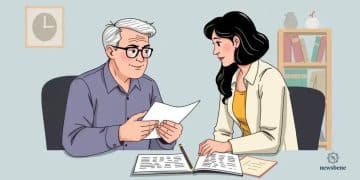Initiatives to forgive federal student loan debt quickly

Initiatives to forgive federal student loan debt include programs like Public Service Loan Forgiveness and Income-Driven Repayment Plans, which significantly reduce borrowers’ financial burdens and enhance economic mobility.
Initiatives to forgive federal student loan debt are gaining traction as students look for financial relief in a challenging economic landscape. Have you ever wondered how these programs can change your life?
Overview of federal student loan debt forgiveness
The overview of federal student loan debt forgiveness highlights the various programs and initiatives aimed at helping borrowers alleviate their financial burdens. Many students now find themselves seeking relief from overwhelming debt, and these initiatives play a critical role in providing that assistance.
Types of Federal Student Loan Debt Forgiveness
There are different paths to forgiveness, each targeting specific groups of borrowers or circumstances. Understanding these options is essential for anyone looking to reduce their financial obligations. Some programs are geared towards public service workers, while others may assist those in financial distress.
- Public Service Loan Forgiveness (PSLF)
- Teacher Loan Forgiveness
- Income-Driven Repayment Forgiveness
- Perkins Loan Cancellation
Each program has its unique requirements. For example, the Public Service Loan Forgiveness program requires borrowers to make 120 qualifying payments while working full-time for a qualifying employer. This can provide substantial relief for those dedicated to careers in public service.
Eligibility Criteria
It’s important to note that eligibility for these forgiveness programs varies. Borrowers must meet specific conditions, such as employment status or income level. Understanding these criteria is a fundamental step in the journey toward forgiveness.
For instance, to qualify for the Income-Driven Repayment Forgiveness, borrowers must have made payments under income-driven plans for a set number of years. This approach ensures that those with lower incomes can access forgiveness, making it a crucial safety net.
As new policies emerge, the landscape of federal student loan debt forgiveness continues to evolve. Keeping abreast of these changes can help borrowers navigate their options and make informed financial decisions.
Key initiatives currently in place
The key initiatives currently in place for federal student loan debt forgiveness provide essential avenues for relief. Various programs support different groups, ensuring a wide range of options for borrowers. Understanding these initiatives can empower students and graduates to take the necessary steps toward financial freedom.
Federal Programs for Debt Relief
One of the most impactful initiatives is the Public Service Loan Forgiveness (PSLF). This program is designed for borrowers who work in qualifying public service jobs, offering forgiveness after 120 qualifying payments. This initiative can significantly reduce the burden of student loan debt for those dedicated to serving their communities.
- Eligibility requirements for PSLF
- Types of qualifying employment
- Step-by-step application process
- Common pitfalls to avoid
Another critical program is Income-Driven Repayment Plans. These plans adjust monthly payments based on a borrower’s income and family size. After making consistent payments for 20 to 25 years, remaining loan balances may be forgiven. This option is particularly valuable for graduates entering lower-paying fields.
Teacher Loan Forgiveness
Teachers can benefit from specific initiatives designed for educational professionals. The Teacher Loan Forgiveness program allows eligible teachers to have a portion of their loans canceled after teaching for five consecutive years in a low-income school or educational service agency. This initiative acknowledges the dedication of educators and helps alleviate their financial stress.
Additionally, borrowers should stay informed about temporary waivers and relief measures, which may arise during economic crises. These short-term solutions can provide immediate assistance and help borrowers manage their repayments more effectively.
Ongoing outreach and information campaigns by the Department of Education aim to ensure that borrowers are aware of these initiatives. Engaging current and former students through social media and community programs can help broaden awareness and encourage participation in available forgiveness options.
Eligibility requirements for debt forgiveness

Understanding the eligibility requirements for debt forgiveness is crucial for borrowers seeking relief. Each forgiveness program has specific guidelines that applicants must meet to qualify. Gathering this information helps individuals navigate their options effectively.
Public Service Loan Forgiveness Requirements
For the Public Service Loan Forgiveness (PSLF) program, borrowers must follow certain steps. First, they must work full-time for a qualifying employer, which includes government organizations and non-profit entities. Additionally, borrowers need to make 120 qualifying payments under a repayment plan to become eligible for forgiveness.
- Must be employed by a qualifying public service organization
- Must make 120 qualifying monthly payments
- Payments must be made under a qualifying repayment plan
- The loans must be Direct Loans
Another significant initiative is the Income-Driven Repayment Plan. Under this plan, borrowers have to provide proof of income and family size. After making payments for 20 or 25 years, any remaining balance may be forgiven, but only if they meet the payment and income verification requirements.
Teacher Loan Forgiveness Eligibility
Teachers have specific criteria to qualify for the Teacher Loan Forgiveness program. They must teach full-time for five consecutive years in a low-income school or educational service agency. This initiative directly addresses the need for educators in underserved areas and offers financial relief for their commitment.
To be eligible, teachers should also have received their loans after October 1, 1998, and they must not be in default on their loans at the time of forgiveness. Awareness of these criteria can help teachers plan their careers strategically to maximize potential benefits.
Borrowers are encouraged to review their loan documents and consult the Federal Student Aid website. Staying informed about eligibility requirements is essential for success in applying for forgiveness programs.
Potential impact on borrowers
The potential impact on borrowers from student loan debt forgiveness can be substantial. As these initiatives evolve, understanding how they can affect individual financial situations is vital. Debt forgiveness can relieve stress and open up new opportunities for many borrowers.
Financial Relief
One of the most significant impacts is the financial relief that forgiveness offers. For example, the Public Service Loan Forgiveness (PSLF) can wipe out significant amounts of debt, allowing borrowers to redirect their finances towards other essential areas, such as housing, education, or savings.
- Reduces monthly payment obligations
- Increases disposable income
- Allows for long-term financial planning
- Assists in building credit scores
Furthermore, the benefits extend beyond just immediate financial relief. Borrowers often experience a sense of empowerment and relief from the burden of debt. This can lead to improved mental health and overall well-being. Moreover, as borrowers gain financial freedom, they can pursue their career goals without the constant strain of student debt hanging over them.
Impact on Economic Mobility
Understanding the broader economic impact is also essential. Forgiveness can enhance economic mobility by enabling borrowers to invest in education, start businesses, or contribute to their communities. A reduced debt burden allows individuals to take calculated risks, such as buying a home or starting a family, which can foster economic growth.
Additionally, in communities with high student loan debt, forgiveness programs can stimulate local economies. When borrowers have more disposable income, they tend to spend more on local goods and services, creating a ripple effect that boosts the entire community.
Future of student loan debt policies
The future of student loan debt policies is a topic of great interest and importance. As the landscape of education financing evolves, new strategies and initiatives are being proposed to address the challenges students face. Policymakers are increasingly focused on making education more affordable and accessible.
Potential Changes in Legislation
In the coming years, we may see significant changes in legislation regarding student loans. One possibility is an expansion of current forgiveness programs, such as Public Service Loan Forgiveness and teacher loan forgiveness. This could include relaxing eligibility requirements, making it easier for borrowers to qualify and receive relief.
- Increased availability of income-driven repayment plans
- New measures to lower interest rates for federal loans
- Funding for improved financial literacy programs
- Support for community colleges and vocational training
Another potential shift includes efforts to address the rising costs of higher education. Universities may be encouraged to offer more affordable tuition rates through state and federal incentives. These moves could ensure that taking on student loans becomes less necessary.
Focus on Equity and Inclusion
Policymakers are increasingly recognizing the need for equity in education financing. The future of student loans will likely strive to address disparities faced by low-income and minority students. This can manifest in targeted programs that help underprivileged groups access financial aid more easily.
Emerging policies may also prioritize reducing the overall debt burden for first-generation college students. This demographic often faces unique challenges, and tailored solutions could significantly elevate their chances of success.
Additionally, technology will play a crucial role in the evolution of student loan policies. Online resources and platforms for managing loans could improve the borrowing experience. Using technology can also streamline the application processes for financial aid and repayment options, making it easier for borrowers to navigate their choices.
FAQ – Frequently Asked Questions about Federal Student Loan Debt Initiatives
What is the Public Service Loan Forgiveness program?
The Public Service Loan Forgiveness program allows borrowers who work in qualifying public service jobs to have their federal student loans forgiven after making 120 qualifying payments.
How can I qualify for teacher loan forgiveness?
To qualify for teacher loan forgiveness, you must teach full-time for five consecutive years in a low-income school or educational service agency and meet specific loan criteria.
Are income-driven repayment plans beneficial?
Yes, income-driven repayment plans can lower monthly payments based on income and family size, and remaining loan balances may be forgiven after 20 to 25 years of qualifying payments.
What should I do to stay updated on student loan policies?
To stay informed, regularly check the Federal Student Aid website, follow news regarding education financing, and participate in community programs that offer information on new policies.






